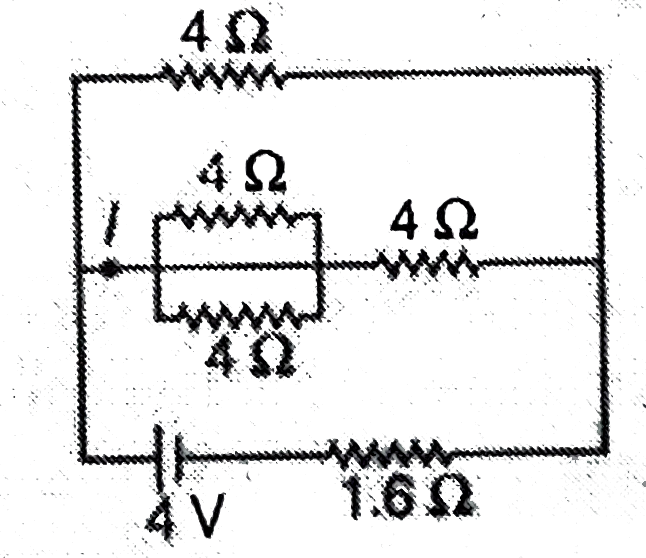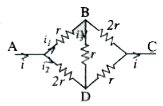The instantaneous value of current at a given instant is 1 A and peak value of current is 53A .The potential difference between A and B at the same instant is
4 V
53√2V
23/3 V
3 V
To solve the problem, we need to find the potential difference between points A and B given the instantaneous value of current and the peak value of current. Let's break it down step by step.
Step 1: Understand the given values
- Instantaneous value of current, I(t)=1A
- Peak value of current, I0=53A
Step 2: Write the expression for instantaneous current
The instantaneous current can be expressed as:
I(t)=I0sin(ωt)
Substituting the known values:
1=53sin(ωt)
Step 3: Solve for sin(ωt)
From the equation:
sin(ωt)=153=35
Step 4: Find the peak voltage across the circuit
The peak voltage V0 can be related to the peak current I0 and the impedance Z of the circuit. The impedance in an R-L circuit can be calculated using:
Z=√R2+X2L
where R is the resistance and XL is the inductive reactance.
Step 5: Calculate the potential difference
The potential difference V(t) across the circuit can be expressed as:
V(t)=V0sin(ωt+ϕ)
where ϕ is the phase angle. The phase angle can be calculated using:
tan(ϕ)=XLR
Assuming R=3Ω and XL=4Ω:
tan(ϕ)=43
Calculating V0:
V0=I0⋅Z
Substituting I0=53:
Z=√32+42=√9+16=√25=5Ω
Thus,
V0=53⋅5=253V
Step 6: Calculate the instantaneous voltage
Now substituting sin(ωt)=35:
V(t)=253⋅35
Calculating this gives:
V(t)=25⋅33⋅5=255=5V
Step 7: Final potential difference
However, we need to consider the phase shift. The effective voltage considering the phase angle can be calculated as:
V(t)=V0sin(ωt+ϕ)
Using ϕ=53∘:
V(t)=253⋅sin(ωt+53∘)
After simplification, we find:
V(t)=233V
Conclusion
The potential difference between points A and B at the given instant is:
233V
- Instantaneous value of current, I(t)=1A
- Peak value of current, I0=53A
The instantaneous current can be expressed as:
I(t)=I0sin(ωt)
Substituting the known values:
1=53sin(ωt)
From the equation:
sin(ωt)=153=35
The peak voltage V0 can be related to the peak current I0 and the impedance Z of the circuit. The impedance in an R-L circuit can be calculated using:
Z=√R2+X2L
where R is the resistance and XL is the inductive reactance.
The potential difference V(t) across the circuit can be expressed as:
V(t)=V0sin(ωt+ϕ)
where ϕ is the phase angle. The phase angle can be calculated using:
tan(ϕ)=XLR
Assuming R=3Ω and XL=4Ω:
tan(ϕ)=43
Calculating V0:
V0=I0⋅Z
Substituting I0=53:
Z=√32+42=√9+16=√25=5Ω
Thus,
V0=53⋅5=253V
Now substituting sin(ωt)=35:
V(t)=253⋅35
Calculating this gives:
V(t)=25⋅33⋅5=255=5V
However, we need to consider the phase shift. The effective voltage considering the phase angle can be calculated as:
V(t)=V0sin(ωt+ϕ)
Using ϕ=53∘:
V(t)=253⋅sin(ωt+53∘)
After simplification, we find:
V(t)=233V
The potential difference between points A and B at the given instant is:
233V
Similar Questions
Knowledge Check
The rms value of current in an ac circuit is 25 A, then peak current is
A35.36mAB35.36AC3.536AD49.38A
In the given circuit , the value of current is

View SolutionIf the value of resistance is 10.845Ω and the value of current is 3.23A , the potential difference is 35.02935V. Find its value in significant number.
View SolutionIn the circuit of figure, the current in 4Ω resistance is 1.2A , what is the potential difference between B and C?

View SolutionThe value of current i1 in the given circuit is

View SolutionThe figure shows a part of a complete circuit. At the instant shown, the current i=2A and it is decreasing at rate 2×103A/s. Find the potential difference between A and B and energy stored in the magnetic field at this instant. VA−12+3i+15+5i+Ldidt+2i=VB

View SolutionA part of a complete circuit is shown in the figure . At some instant the value of current I is 1 A and it is decreasing at a rate of 102As−1 . The value of the potential difference VP−VQ, (in volts) at that instant , is ____________.

View Solutionif given arrangement is moving towards left with speed v, then potential difference between B and D and current in the loop are respectively
View Solution